How to clean dry closets: features of cleaning peat and liquid varieties of dry closets
Dry closet is an extremely convenient, aesthetic and environmentally friendly device. There are models that are suitable for giving, and devices suitable for use in the apartment. They vary in type of processing, size, productivity and other characteristics.
When making a purchasing decision, you need to find out how to clean the dry closet, since its effectiveness depends on the proper maintenance of this device. In this article, we will deal with the features of dry closet care, for which we first get acquainted with the device and the principle of operation of liquid and peat models.
The content of the article:
The device and the specifics of the dry closet
Hygienic devices of this type are quite diverse. Often dry closets divided into liquid and peat. For the former, various liquid preparations are used as a means of processing waste, and secondly, dry peat.
Features of fluid models
Such devices usually consist of two parts. On top is the toilet bowl and flush tank modification, and below is a spacious container for collecting and processing waste. The upper part has a reservoir that is filled with water or flushing solution. There is also a pump, with its help liquid under pressure enters the toilet.
The pump can be electric or mechanical, the type of action is:
- pump action
- piston.
Electric pumps run on mains or on batteries. They are very easy to use, most importantly, do not forget to timely replace the used batteries with new ones. Mechanical pumps are triggered by pressing on the corrugated element. They do not require additional effort to perform flushing. Owners note the high maintainability of such devices.
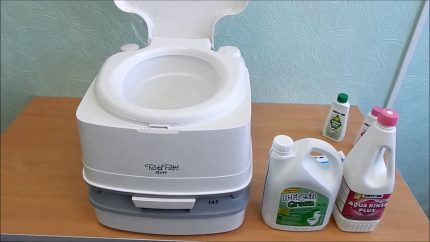
But pump-action mechanical models do not allow controlling the amount of fluid coming from the tank and the pressure inside it. A piston device is a little harder to use. The lever will have to be pressed several times to create the desired pressure level.
Water is poured into the tank through the hole provided for this. Of course, the toilet is covered. After using the dry closet for its intended purpose, you just need to press the pump lever to flush.
A durable rubber gasket is installed between the upper and lower sections, which prevents liquid from penetrating outward and also blocks unpleasant odors. There is a connecting valve, which opens to move sewage into the lower compartment, and the rest of the time remains closed.
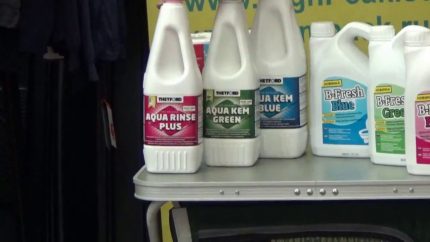
Two more mechanisms are provided for controlling the device: a pressure relief valve and a separation valve. The first is needed to protect the tank from overloads, and the second connects the parts of the dry closet.
Some models have a very useful addition on the bottom tank body - the fill indicator. It allows you to understand that you need to start the cleaning procedure. Different types of liquids are used for waste processing.
Chemical compositions contain formaldehyde. They cope well with odors, but are harmful to the environment. The result of processing must be poured into the sewer.
Biological fluids, unlike chemical ones, are completely loyal to the environment. They recycle waste into compost or a neutral liquid. This is a more relevant option in the country or in a private house.
Sludge decomposing compounds are poured both into the tank provided for flushing, located in the upper part of the structure, and into the lower tank, in which direct processing is carried out.
Manufacturers offer additional compounds that deodorize the water in the tank and improve the procedure for removing the contents of the toilet. It is useless to use such products without substances intended for the decomposition of sewage.
Peat-filled toilet
Such a dry closet works differently, therefore it is arranged and used differently. Chemical or biologically active liquid is not used in peat models, only dry filler.

The hygienic device has a spacious lower compartment, in which a durable bowl is installed. A layer of peat is poured onto the bottom of the tank. From above, the compartment is closed with a lid, in which a hole and a seat are made. On top of the peat models is a small tank resembling a regular tank. It is also filled with dry peat.
Sewage immediately enters the bowl with the filler, as it is filled from the upper compartment, the tank, with the help of a dispenser, additional portions of neutralizing peat or peat mixture are filled with it. To do this, turn the lever on the device body: it activates the dispenser, which is responsible for the uniform distribution of the substance.
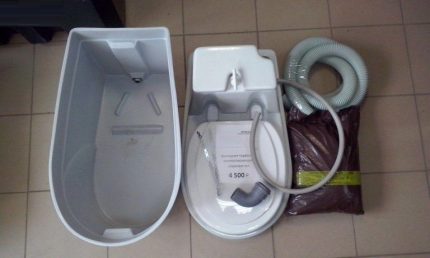
It is clear that in such a model, odors are held weaker than when using liquid hygiene devices. Therefore, it is recommended to install the peat toilet only in private houses, in a separate, well-ventilated room. For a city apartment, this option is categorically unacceptable.
We have a comparative review of peat, liquid and chemical dry closets on our site.To determine the best version of the dry closet, please go to this link.
Peat models have two undoubted advantages. Waste turns into valuable fertilizer, and the design is so simple that it can be made independently from improvised means.
But in any case, you need a place to store spent peat (usually a compost pit). The neutralizer also needs a special one: dry, loose, lumps are not allowed. Such peat is bought in stores.

There are separator models of dry closets. These are electrical options, similar to peat recycling waste products into the starting material for compost heaps. During processing, they use neither peat nor liquid, the action is based on drying and pressing.
In electrical models, liquid waste is separated from solid waste, removed by a hose to the outside and immediately disposed of into the ground. Such devices can be made “two-story”: the toilet itself is placed on top, and the containers for collecting sewage are placed under it or even hidden under the floor. This partially solves the odor problem.
You have not purchased a dry closet yet and just choose the right option? In this case, we recommend that you familiarize yourself with rated best modelsin high demand among buyers.
Cleaning and care
Over time, the dry closet needs to be cleaned of accumulations.
This is done simply:
- Remove the waste container.
- Move them to the sewer, compost pit, etc.
- Clean the tank of remaining contaminants.
- A fresh portion of the neutralizing agent is added.
- Set the tank in place.
But for each model there are certain nuances. Usually they are described in detail in the instructions that accompany the device.
Instruction # 1 - Cleaning the Liquid Model
Disposal containers in such devices fill up pretty quickly, so you need to clean them often. It is important to disassemble the device correctly so as not to break it. The procedure depends on the structural features of a particular model.
For example, the Enviro 10 dry closet is cleaned as follows:
- First you need to check the condition of the drain valve, it must be closed.
- Now you should slide the side latches and remove the upper part of the device.
- After that, the lower container can be taken by the handle and taken to the place of waste disposal.
- The tank is turned upright.
- Then slowly open the cover from the drain hole.
- Wait until the gases accumulated inside the container come out of it.
- Pour the waste into a sewer or compost storage site.
- Wash both containers.
- Assemble the device in the reverse order: close the lid, fix the position with latches, check the drain valve.
- Fill reservoirs with appropriate fluids.
Pour the contents of the tank through the hole for filling fluid. You can not use for these purposes a clearance located at the top in the center, it must be blocked by a valve. This model does not have an indication of tank filling, so the need for cleaning is indicated by the inability to properly drain the water.
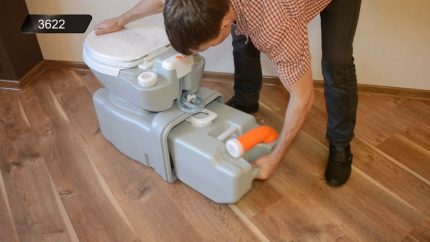
Understanding how often such a toilet needs to be cleaned will come with time.
Liquid dry closets need regular maintenance. They need to be cleaned in much the same way as a normal toilet, using household chemicals.

But you need to make an allowance for the fact that plastic can be damaged by aggressive substances. Follow manufacturer's directions. A brush that is too stiff can cause mechanical damage.
Instruction # 2 - peat toilet maintenance
Such models fill up much more slowly than liquid counterparts. Depending on the intensity of use, the container with peat and waste must be released once every six months to a year, and sometimes only once every several years. It is not difficult to do this, since the design of such devices is very simple.
A mixture of peat and sewage is in a plastic container under the lid with a seat. You need to lift this lid and pull out the container. It is usually equipped with a convenient carrying handle. After that, the container with the filler is assigned to a compost pit or other place that is provided for the disposal of such waste.
The contents of the container are poured out or shaken out. After that, you need to wash the container, put a layer of prepared peat on its bottom and put it in place. The toilet can be used again. For separator models, the cleaning scheme is exactly the same, but because of drying and pressing they have to be emptied much less frequently.
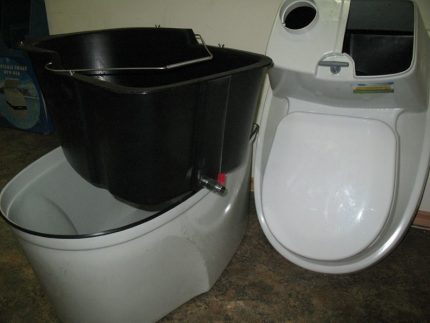
Of course, such a dry closet should be regularly cleaned of current pollution. For this, you can use the usual household chemicals.
It should be remembered that some manufacturers do not recommend cleaning such devices with formulations containing chlorine, concentrated acids and other aggressive chemicals.
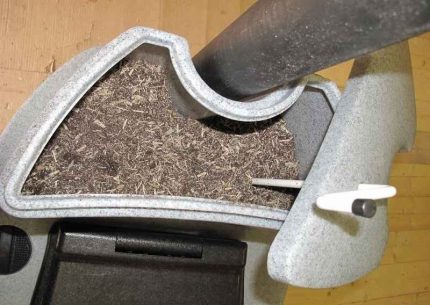
It is not recommended to throw used toilet paper in a peat dry closet. Such inclusions will make the filler heterogeneous and worsen the processing process. For liquid models, only certain types of toilet paper may be disposed of.
Peat filler, if desired, can be supplemented with sawdust, if available on the site. The materials are mixed in a ratio of 1: 1. But the sawdust should be small, and the total volume of filler in the tank should be large enough. For small toilets, using this supplement is not recommended.
If desired, a peat toilet model can be made by yourself. And how to do it right and what materials will be needed for this we examined in next article.
Conclusions and useful video on the topic
How to use the dry closet:
Peat model cleaning:
The dry closet needs to be cleaned regularly so that it works exactly as expected from it. This is not a very complicated procedure, you just need to follow the instructions so that the process goes quickly and efficiently.
Are you going to do maintenance of the dry closet, but you still have questions after reading the above material? Ask them to our experts in the block below.
Or maybe you want to share useful tips on the proper care of the dry closet with other users? Write comments, share experiences under this article.

 Rating of dry closets for a summer residence and a private house: popular models + recommendations for customers
Rating of dry closets for a summer residence and a private house: popular models + recommendations for customers 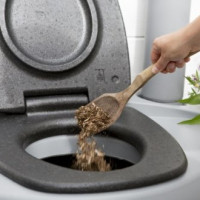 Peat Toilet Fillers: A Comparative Review and Selection Tips
Peat Toilet Fillers: A Comparative Review and Selection Tips 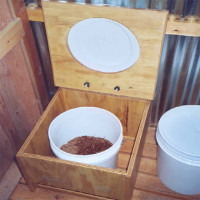 DIY dry closet: a step-by-step guide to the construction of a peat dry closet
DIY dry closet: a step-by-step guide to the construction of a peat dry closet  How to choose a dry closet for a summer residence: tips for choosing and an overview of the best models
How to choose a dry closet for a summer residence: tips for choosing and an overview of the best models 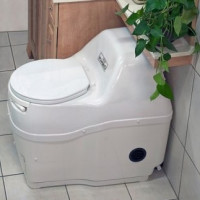 What is a dry closet: the principle of operation and the specifics of using autonomous plumbing
What is a dry closet: the principle of operation and the specifics of using autonomous plumbing 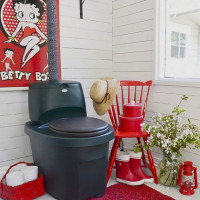 Which dry closet is better: liquid or composting? What to buy: peat or chemical option
Which dry closet is better: liquid or composting? What to buy: peat or chemical option  How much does it cost to connect gas to a private house: the price of organizing gas supply
How much does it cost to connect gas to a private house: the price of organizing gas supply  The best washing machines with dryer: model rating and customer tips
The best washing machines with dryer: model rating and customer tips  What is the color temperature of light and the nuances of choosing the temperature of the lamps to suit your needs
What is the color temperature of light and the nuances of choosing the temperature of the lamps to suit your needs  Replacement of a geyser in an apartment: replacement paperwork + basic norms and requirements
Replacement of a geyser in an apartment: replacement paperwork + basic norms and requirements
We bought a peat dry closet at the cottage and put it on the street, equipping a box of summer toilet. Since we have a garden, we use fertilizer rotted in a compost pit. Peat is also a fertilizer for the soil, so the contents of the dry closet are drained from the compost pit, we are waiting for decay and fertilize the soil. Installed on the street, as there is a smell.
In the summer we live with my wife in the country 4-5 days a week, use the dry closet. Unfortunately, with such an operation, chemistry does not have time to completely process the contents of the dry closet and cleaning it is not a very pleasant experience. Maybe someone faced this? Will replacing chemistry with another brand or something else help?
In this case, it makes sense to choose another manufacturer of chemistry. I can also advise you to consider the option of a peat toilet. It is quite easy to maintain:
- dry peat changes every few months (you can dig in the area);
- a container with peat is located under the cabin and is easily removed;
- you need a small container to drain the liquid (just in case).
The advantage is that chemistry is not used, but natural peat, which does not need to be far removed and disposed of. The article also has a video on how such a toilet is easily maintained. What chemistry are you using now?